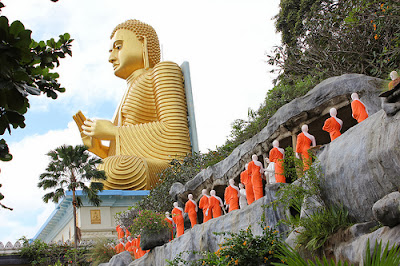A.G.S. Kariyawasam, "Buddhist Ceremonies and Rituals of Sri Lanka" (ATI), Ashley Wells, Amber Larson, Dhr. Seven, CC Liu, Pat Macpherson, Seth Auberon, Dev, Xochitl, Wisdom Quarterly
 |
| A new day dawns atop the world (Raimond Klavins/artmif/flickr.com) |
 |
| Sri Lanka is the teardrop-island off India |
Sri Lanka is regarded as a home of Theravada, a less diluted
form of Buddhism based on the ancient Pali canon. This school of
Buddhism emphasizes the Four Noble Truths as the framework of the Buddha's Dharma or Teaching and the Noble Eightfold Path as the direct route to nirvana,
the final goal of the Teaching.
 |
| Buddha, Dambulla, Sri Lanka (NH53/flickr) |
However, side by side with this austere and
intellectually sophisticated Buddhism of the texts, there is in Sri
Lanka a warm current of devotional Buddhism practiced by the general
Buddhist population, who may have only a hazy idea of Buddhist
doctrine.
In practical life, the gap between the "great tradition"
of canonical Buddhism and the average person's world of everyday
experience is bridged by a complex round of ceremonies, rituals, and
devotional practices that are hardly visible within the canonical texts
themselves.
- Faith (saddha) in Buddhism
- Manual of Buddhist Terms and Doctrines
- Going for "refuge" to Buddha, Dharma, Sangha?
The specific forms of ritual and ceremony in the popular mind doubtlessly evolved over the centuries. Likely this devotional approach to the Dharma had its roots in lay Buddhist
practice during the time of the Buddha in neighboring India.
 |
| Pilgrimage (yatra): Hiking into the clouds of Sri Lanka Gunner's Point (NH53/flickr) |
For Buddhism, devotion does not mean submitting oneself
to the will of a God or a Buddha or taking "refuge" in an external savior. Rather, it is an
ardent feeling of love and affection (pema) directed towards the teacher who shows the way to freedom and liberation from all suffering.
Such an attitude
inspires the devotee to follow a meditation master's teaching faithfully and
earnestly through all the hurdles that lie along the way to nirvana.
 |
| Aukana Buddha, Sri Lanka (visitserendib.com) |
The Buddha often stressed the importance of saddha, confidence or faith in a buddha as the best of teachers, the Dharma or Teaching as the direct
vehicle to liberation from the cycle of rebirth-and-suffering, and the Nobles (Ariya-Sangha), those taught the path all the way to success, to direct verification in this very life, to enlightenment.
Unshakeable confidence (aveccappasada)
in the Triple Jewels -- Buddha, Dharma, and Noble Sangha -- is one mark
of enlightenment.
The Buddha once stated that those who have
sufficient confidence in him (saddha-matta), sufficient affection for him (pema-matta) are bound for rebirth in heavenly worlds as a result of that (mental/heart based) karma. But the heavens are not the goal of Buddhists, who instead aim for final peace, the end of all rebirth and death. (Heavenly rebirths mean eventual falling away when the karma that led one there is exhausted).
 |
| Buddha in Theravada Sri Lanka (WQ) |
Many verses of the Theragatha and Therigatha, verses of the ancient elder-monks (theras) and -nuns (theris), convey feelings of deep devotion and a high level of emotional elation.
Although the canonical texts do not indicate that this devotional
sensibility had yet come to expression in fully formed rituals, it seems
plausible that simple ritualistic observances with feelings
of devotion had already begun to take shape even during the Buddha's
lifetime.
Certainly they would have done so shortly after the
Buddha's final reclining into nirvana, as is amply demonstrated by the cremation rites themselves,
according to the testimony of the discourse on the Great Final-Nirvana (Maha-Pari-nibbana Sutta).
| Relics in housed in white stupa, Ruwanwelimahaseya, Ramagama, Sri Lanka (wiki) |
The Buddha in a sense encouraged a devotional attitude when recommending pilgrimage locations, namely,
the four places that can inspire a confident devotee: where
he was born, attained enlightenment, delivered the first sermon, and
attained final nirvana (DN.ii,140).
The Buddha did discourage the wrong kind of emotional attachment to him or anything, as evidenced in the case of Ven. Vakkali Thera, who was reprimanded
for his obsession with the beauty of the Buddha's physical appearance: This
is a case of misplaced devotion (S.iii,119).
Ritualistic observances
also pose a danger that they might be misapprehended as ends in
themselves -- instead of being used as they should be when employed as means for channeling
devotional emotions into the right path to the ultimate goal.
It is when they are wrongly
practiced that they become impediments rather than aids to the spiritual
life.
It is to warn against this that the Buddha has categorized them,
under the term "devotion to mere rules and rituals" (silabbata-paramasa), one of the Ten Fetters (samyojana) binding one to samsara, the Wheel of Rebirth and Suffering, and one of the four types of clinging (upadana).
 |
| Where Buddhism arrived from ancient India, Mahintale, Sri Lanka (NH53/flickr) |
Correctly observed, as means rather than ends, ritualistic practices can
serve to generate wholesome states of mind/heart, while certain other rituals
collectively performed can serve as a means of strengthening the social
cohesion among those who share the same spiritual ideals.
Ceremonies and rituals, as external acts which complement inward
contemplative exercises, cannot be called alien to or incompatible with
canonical Buddhism. To the contrary, they are an integral part of the
living tradition of all schools of Buddhism, including the Theravada.
A ritual may be defined here as an outward act performed regularly
and consistently in a context that confers upon it a religious
significance not immediately evident in the act itself. A composite
unity consisting of a number of subordinate ritualistic acts may be
called a ceremony. More
Happy New Year from Wisdom Quarterly































































































































































































































No comments:
Post a Comment